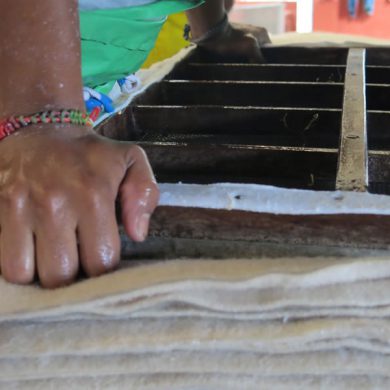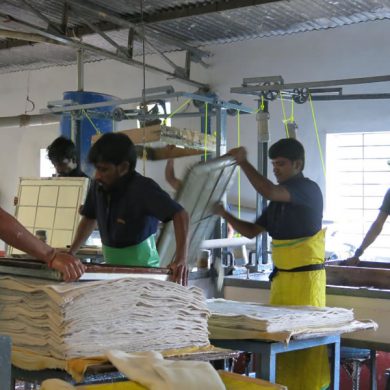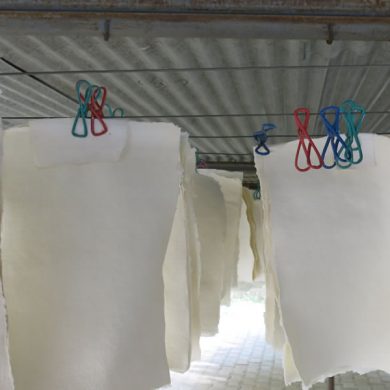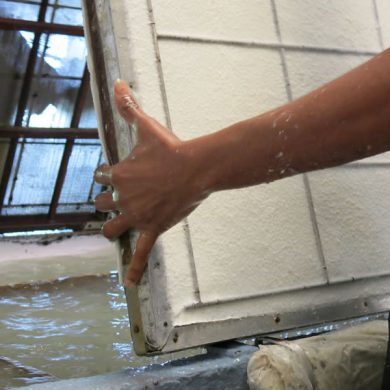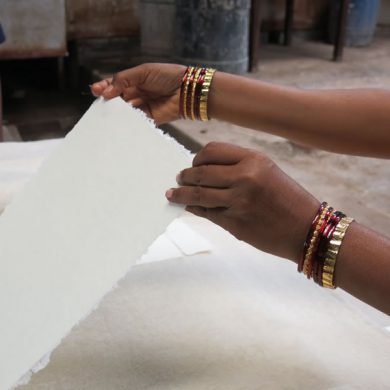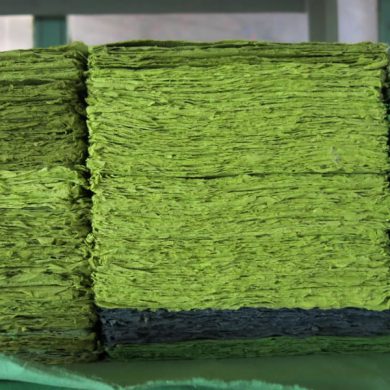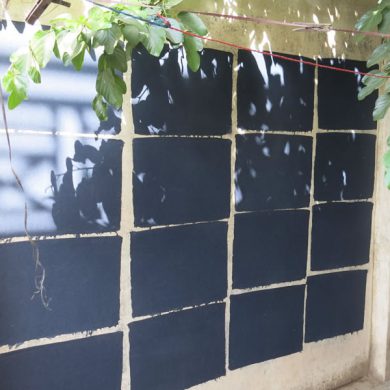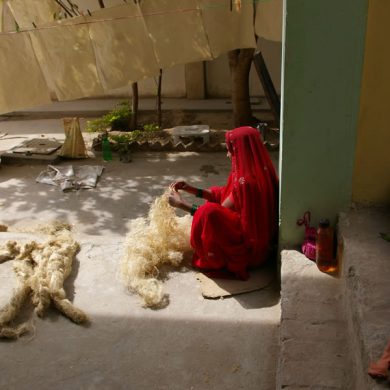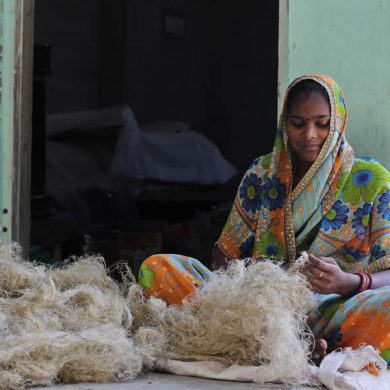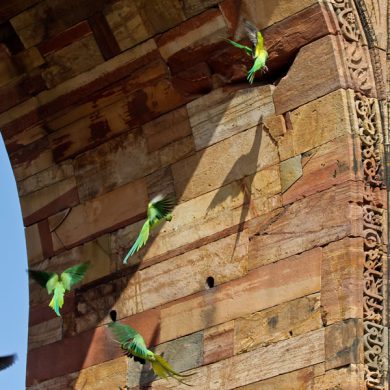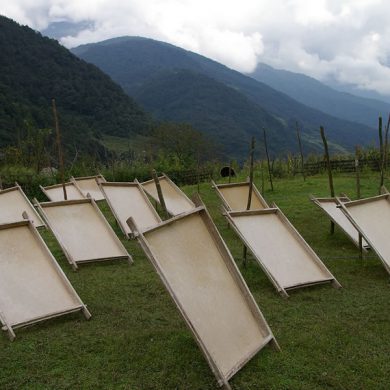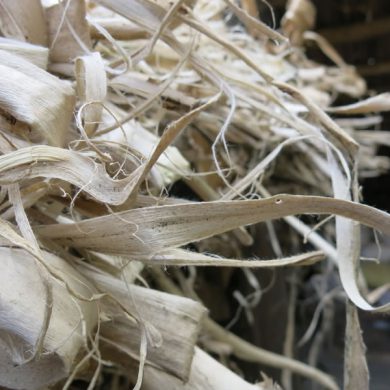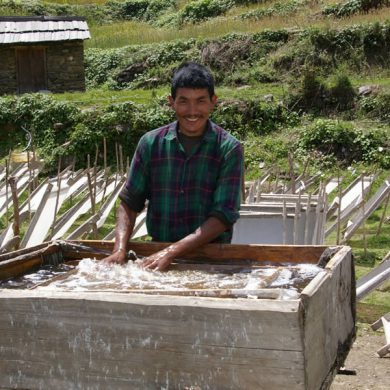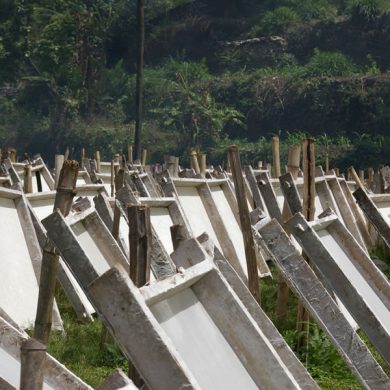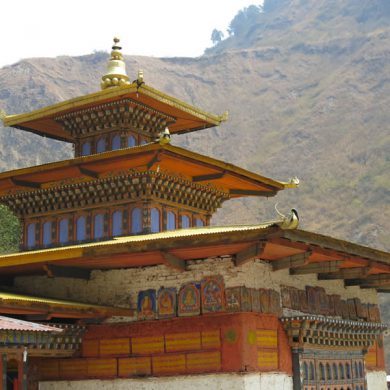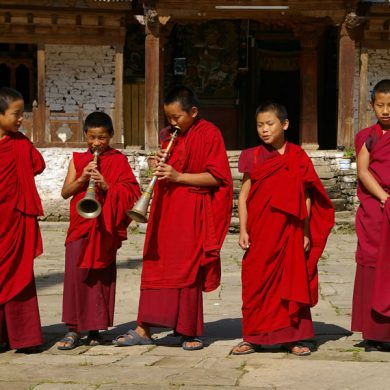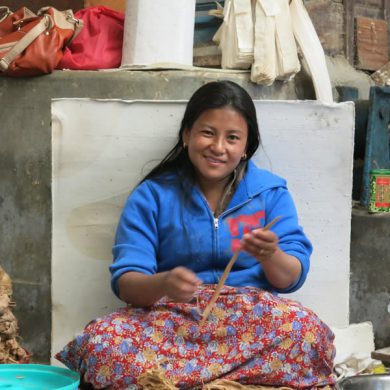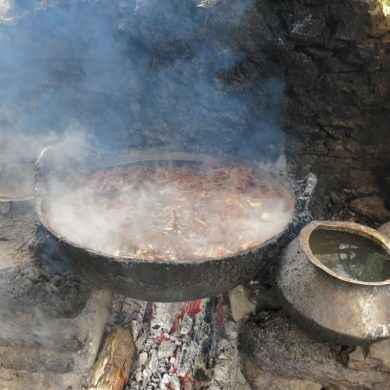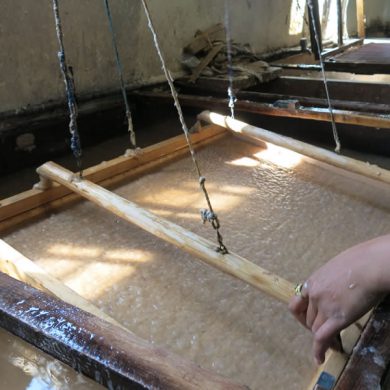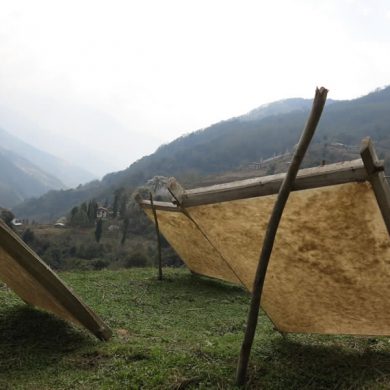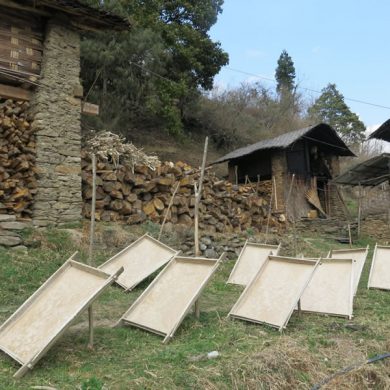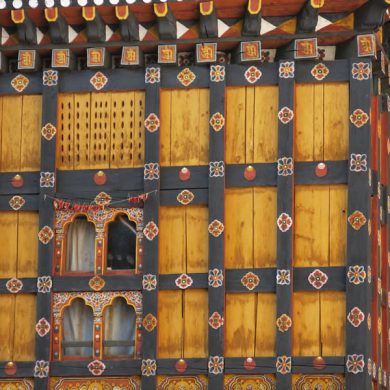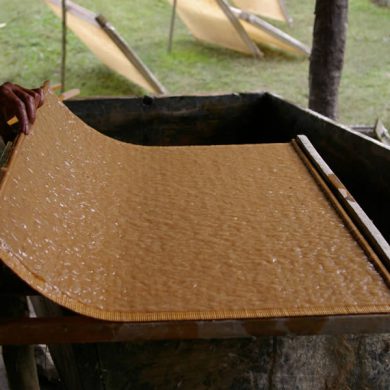About the paper
South India
KHADI RAG PAPERS are made in Karnataka, South India at our paper mill, KHADI PAPERS INDIA.
They are made from 100% cotton rag. Cotton rags have longer fibres than linters which are the short fluffy fibres of the cotton seed often used in papermaking. Genuine rag papers are rare and it is the fibre length of this raw material that gives Khadi rag papers their exceptional strength and durability. The cotton rag we use comes from T-shirt cuttings, a reliable source of pure woven cotton.
Rags are pulped in a Hollander beater. Neutral pH internal size is added at this stage. Khadi rag papers are the only handmade papers in India made with neutral pH size and so they are the only ones that are genuinely acid free.
Coloured papers are dyed in the beater using direct dyes from Ciba and Clariant which are ISO 9001 accredited and meet European standards on effluence and toxicology. Increasingly we are sourcing coloured rags enabling us to reduce or entirely avoid the use of dye.
Handmade papers are made sheet by sheet, not in a continuous roll. Cotton fibres in suspension in water are poured onto a paper mould which is a hand held wooden frame with a stainless steel wire mesh draining surface.
The sheet is formed on the mould in a vat of water. On top of the mould is a removable frame called a deckle which holds the pulp in place. The process involves a very small amount of fibre and a lot of water. The characteristic deckle edges of the sheet of paper come from the slippage of pulp between the deckle and the mould.
The mould is lifted from the vat and the sheet is laid or couched onto a woollen felt. Another felt is placed on top and the process is repeated. When a pile of sheets interleaved with felts has been made they are pressed in a hydraulic press to remove excess water.
Rough surfaced papers retain the impression of the woollen felt. Smooth papers are cold pressed between zinc sheets.
Papers are loft dried. After drying, sheets are tub sized (surface sized) with gelatine which produces a hard, water resistant surface. This is the traditional way of sizing paper for watercolour, allowing watercolour to be worked over the surface without penetrating the paper. The papers can be used with all painting and drawing media. For painting in oils they should be primed with gesso or acrylic primer.
North India
HEMP PAPERS are made from sunn hemp, a native fibre used in India in the past for rope making. Sunn hemp was the raw material of the Islamic papers made by India’s traditional papermakers, the Kagzi who arrived in India from Samarkand and Bukhara in Central Asia during the 14th and 15th centuries. There is now possibly only one family of kagzi papermakers in India still making sunn hemp papers in the traditional way and this is the family of Hussain Kagzi in Sanganer, Rajasthan.
The papers are made on a chapri, a paper mould made from hollow grass stems strung together a little like a bamboo sushi mat. The chapri leaves an impression of fine lines in the paper which is characteristic of Islamic papers.
We have a collection of rare papers from Hussain’s workshop. These include papers dyed with natural dyes, indigo, madder, catechu and pomegranate. All of Hussain’s papers are stone burnished to give a polished smooth surface. We also offer pages from old ledgers, most dating from the late 19th century, made using the same methods that Hussain uses today.
NEPAL
NEPALESE PAPERS are made from the inner bark fibre of lokta or argeli, plants that grow in the high altitude forests of the Himalayan foothills. Lokta (daphne bholua) grows above 3000 metres and produces a strong durable paper. Argeli (edgeworthia papyrefera) is found above 2000 meters and makes a softer, more delicate paper. Argeli fibre is also used for papermaking in Japan where it is called mitsumata. These fibres are a renewable resource. Plants are cropped above ground level and re-grow from the radial root. They can be reharvested after 3 to 4 years.
The stripped bark is boiled in an alkali solution which breaks down the lignin in the cell walls allowing the fibres to separate. Traditionally a lye of ashes was used for this purpose, formed by dripping water through a basket of hardwood ashes. In the last 20 to 30 years this has been replaced throughout Nepal by caustic soda. Caustic soda, however, damages the fibres producing paper that lacks the strength and durability of traditional Nepalese papers. Our lokta papers are the only papers produced in Nepal using soda ash instead of caustic soda. This does not harm the fibres and results in papers of a quality not seen in Nepal for a generation. The run-off can also be used as a fertiliser so the environmental impact is actually positive.
Our mountain papers are made on a traditional Nepalese paper mould which is a wooden frame with a thin cotton cloth stretched over its surface. The paper is dried on the frame which is propped up and angled towards the sun. This is the most primitive way of making paper, unchanged for over 1000 years.
Our Nepalese washi is paper made using the Japanese dipping and layering method called nagashizuki. In this method the sheet is formed on a mat of fine bamboo called a su. The wet sheet is transferred from the su onto a pile of sheets which are then pressed to remove water. No interleaving with felts is necessary. The sheets of paper are carefully separated and brushed onto zinc sheets to dry.
BHUTAN
Remote and landlocked in the eastern Himalayas the kingdom of Bhutan is for good reason subtitled Druk Yul, Land of the Thunder Dragon. It’s a place of electrical storms, swirling mists and mountains with plume of snow smoke blowing from their summits. Steep forested hillsides drop down to fast flowing boulder strewn rivers. Nature is powerful here. The forests seem limitless and the people fear the spirits that inhabit them.
BHUTANESE PAPERS are made from the same kind of high growing fibres that are found in Nepal. These are denak, which is Bhutanese lokta, and dekar which is Bhutanese argeli. KHADI PAPERS have worked with papermakers from Bhutan since the early 1980s. From Eastern Bhutan we have traditional papers made by local farmers who regard paper almost as another crop, along with buckwheat, mustard and chilli. These papers are still used in Bhutan and Tibet for block printed or hand written Buddhist manuscripts. From Tshering Dorji’s paper workshop in Thimpu, Western Bhutan, we have a collection of papers including, two stunning extra large Japanese style washi papers, earth coloured papers made with ground black, red and yellow Bhutanese earth, and a blue black paper made with pigment from lapis lazuli.
